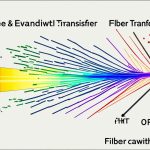Optical Transport Network (OTN) standards are fundamental in revolutionizing data transport over optical fiber networks, providing significant enhancements in terms of efficiency and reliability. These standards, defined by ITU Recommendations such as G.709 and G.798, establish a framework for the seamless integration of various network technologies, enabling the transportation, switching, and multiplexing of different services over high-capacity wavelengths.
The OTN standards structure the optical transport module (OTM) transported across the optical interface. It comprises the Optical Channel Payload Unit (OPU), the Optical Channel Data Unit (ODU), and the Optical Channel Transport Unit (OTU). These hierarchical layers facilitate the efficient mapping and multiplexing of diverse client signals onto the OTN network, ensuring optimized data transport.
The Role of OTN in Enhancing Network Performance
OTN standards offer a range of features that significantly enhance network performance. One key feature is Forward Error Correction (FEC), which plays a crucial role in improving the tolerance of network impairments. By correcting and detecting errors in the optical link, FEC increases the system margin and allows for longer spans between optical repeaters. This reduction in capital and operational expenses is a significant advantage for network operators.
Tandem Connection Monitoring (TCM) is another important aspect of OTN that enhances network performance. It enables end-to-end monitoring across different network domains, enabling improved fault detection and troubleshooting capabilities. Through TCM, network operators can proactively identify and address issues, minimizing downtime and improving overall network reliability.
OTN also provides transparent transport of client signals, preserving their native structure, timing information, and management information during transmission. This ensures that the integrity of the client signals is maintained throughout the network, leading to enhanced network performance.
Furthermore, OTN offers switching scalability to efficiently and flexibly switch client signals within the network. This capability allows network operators to optimize the utilization of network resources and adapt to changing traffic patterns and demands.
This combination of features makes OTN a powerful solution for enhancing network performance, providing network operators with the tools needed to deliver reliable and efficient data transport.
Benefits of OTN in Enhancing Network Performance:
- Improved tolerance to network impairments through Forward Error Correction (FEC)
- Enhanced fault detection and troubleshooting capabilities with Tandem Connection Monitoring (TCM)
- Preservation of client signal integrity through transparent transport
- Efficient and flexible switching of client signals within the network
Now that we understand the role of OTN in enhancing network performance, let’s delve deeper into the OTN hierarchy and frame structure in the next section.
| Feature | Description |
|---|---|
| Forward Error Correction (FEC) | Improves tolerance to network impairments by correcting and detecting errors in the optical link |
| Tandem Connection Monitoring (TCM) | Enables end-to-end monitoring across different network domains for improved fault detection and troubleshooting |
| Transparent Transport | Preserves the native structure, timing information, and management information of client signals during transmission |
| Switching Scalability | Provides efficient and flexible switching of client signals within the network |
The OTN Hierarchy and Frame Structure
The Optical Transport Network (OTN) is built upon a hierarchical structure that enables the efficient transport and multiplexing of client signals across optical fiber networks. This hierarchy consists of different layers, each playing a crucial role in the smooth operation of the network.
At the core of the OTN hierarchy is the Optical Transport Unit (OTU), which serves as the transport layer for carrying the Optical Channel Transport Unit (ODU) signals. The OTU is responsible for encapsulating and framing the ODU signals, ensuring their reliable delivery across the network.
The ODU signals, represented by different forms such as ODU1, ODU2, ODU3, and ODU4, carry various client services including IP, Ethernet, storage, and SONET/SDH. These signals have different bit rates and mapping schemes that enable efficient integration of diverse network technologies.
Within the ODU layer, additional information is included in the overhead section to support monitoring and fault detection. This includes the BIP-8 (Bit Interleaved Parity) for error detection and correction, TTI (Trail Trace Identifier) for tracing the network topology, and BDI (Backward Defect Indicator) for fault detection purposes.
Next in the hierarchy is the Optical Channel Payload Unit (OPU), responsible for carrying the payload frames that contain the client data. The OPU is associated with the mapping and multiplexing of the client signals, ensuring their seamless integration into the OTN network.
OTUk Frame Structure and Synchronization
The OTN frame structure, known as OTUk, contains specific overhead bytes that enable synchronization and monitoring of the OTN network. These overhead bytes facilitate functions such as frame alignment, multiplexing/demultiplexing, and performance monitoring of the transported signals. The OTUk frame structure ensures the efficient and reliable operation of the OTN network.
In summary, the OTN hierarchy and frame structure provide the foundation for efficient mapping, multiplexing, and transport of client signals across optical fiber networks. Through the OTU, ODU, and OPU layers, different services and data types can be seamlessly integrated into the network. The OTN frame structure further enhances synchronization and monitoring capabilities, ensuring the reliable operation of the OTN network.
Mapping and Multiplexing in OTN
Optical Transport Network (OTN) provides efficient mapping and multiplexing mechanisms to facilitate the transport of different client signals across the network. This ensures seamless integration of various network technologies and maximizes network capacity utilization.
Client Signal Mapping: OTN allows for the direct mapping of SONET/SDH and Ethernet signals into OTN Optical Channel Payload Units (OPUs), preserving their structure and timing information. This ensures that the client signals are accurately transported without any loss of data integrity.
Layer-2 Signal Mapping: The Generic Framing Procedure (GFP) enables the mapping of various Layer-2 signals, such as IP and Ethernet, into SONET/SDH or ODU frames. This flexibility allows for the transport of a wide range of client services while maintaining compatibility with existing network infrastructure.
Mapping Example
Table: Mapping Example
| Client Signal | Mapping |
|---|---|
| SONET/SDH | Direct mapping into OTN OPUs |
| Ethernet | Direct mapping into OTN OPUs or through GFP into SONET/SDH or ODU frames |
| Layer-2 Signals | GFP mapping into SONET/SDH or ODU frames |
Multiplexing: OTN supports the multiplexing of multiple client signals onto high-bit-rate wavelengths using Wavelength Division Multiplexing (WDM) technology. This allows for the efficient sharing of the optical network resources and maximizes the utilization of network capacity.

Through mapping and multiplexing, OTN provides a versatile and flexible solution for transporting different types of client signals, ensuring efficient data transport and optimal network performance.
Benefits of OTN for Network Operators
Network operators can derive several benefits from deploying Optical Transport Network (OTN) in their networks. First and foremost, OTN improves network performance through features like Forward Error Correction (FEC), which enhances system margin and allows for longer span lengths. This results in improved network reliability and reduced operational expenses.
OTN also simplifies network operations through built-in fault detection and troubleshooting capabilities, such as topology tracing and error detection. With these features, network operators can quickly identify and resolve network issues, leading to simplified operations and increased efficiency.
Faster service turn-up is another advantage of OTN. When implementing new services, network operators can add them quickly and efficiently without the need for extensive reconfigurations. This greatly reduces service activation time and enables operators to meet the demands of their customers in a timely manner.
Furthermore, OTN allows for the maximization of network efficiency. By efficiently mapping and multiplexing client signals, OTN eliminates stranded bandwidth and ensures optimal utilization of network capacity. This translates to improved network efficiency and cost savings for network operators.

In summary, OTN offers network operators a range of benefits, including enhanced network performance, simplified operations, faster service turn-up, and network efficiency. By harnessing the power of OTN, operators can optimize their networks for superior performance and deliver reliable services to their customers.
Conclusion
In conclusion, the implementation of OTN standards is essential for enhancing data transport over optical fiber networks. By combining time-division multiplexing (TDM) and wavelength-division multiplexing (WDM), OTN establishes a common transport system that facilitates the seamless integration of various client signals. The hierarchical structure of OTN, along with its advanced mapping and multiplexing capabilities, ensures efficient and reliable transport of different services.
Network operators can greatly benefit from implementing OTN in their networks. OTN standards offer improved network performance, enabling operators to achieve better efficiency and reliability. With features like Forward Error Correction (FEC) and Tandem Connection Monitoring (TCM), OTN enhances the network’s tolerance to impairments and provides end-to-end monitoring capabilities for fault detection and troubleshooting.
Furthermore, OTN simplifies network operations by providing built-in fault detection mechanisms and troubleshooting capabilities, reducing the need for extensive manual interventions. With faster service turn-up times, operators can quickly add new services to the network, enabling rapid deployment and growth. Additionally, OTN maximizes network efficiency by efficiently mapping and multiplexing client signals, ensuring optimal utilization of network capacity and minimizing stranded bandwidth.
Overall, OTN, with its standardized approach and comprehensive features, offers a future-proof solution for network operators to enhance data transport in optical networks. By adhering to OTN standards, operators can achieve enhanced network performance, simplified operations, faster service turn-up, and maximized network efficiency, ensuring a seamless and reliable experience for their users.
FAQ
What are OTN standards?
OTN standards refer to the specifications defined by various ITU Recommendations, such as G.709 and G.798, that define the structure and functionality of the Optical Transport Network (OTN) system.
What is the role of OTN in enhancing network performance?
OTN enhances network performance through features like Forward Error Correction (FEC) that improve system margin, Tandem Connection Monitoring (TCM) for fault detection, and transparent transport of client signals, enabling seamless integration of different network technologies.
What is the hierarchy and frame structure of OTN?
The OTN hierarchy consists of layers like OTUk, ODUk, and OPUk. The frame structure of OTN includes overhead bytes that facilitate synchronization and monitoring of the OTN network.
How does OTN enable mapping and multiplexing of client signals?
OTN enables efficient mapping and multiplexing of client signals through mechanisms like direct mapping of SONET/SDH and Ethernet signals, Generic Framing Procedure (GFP) for mapping Layer-2 signals, and multiplexing of multiple client signals onto high-bit-rate wavelengths using WDM technology.
What are the benefits of using OTN for network operators?
Network operators benefit from using OTN as it improves network performance, simplifies operations with built-in fault detection and troubleshooting capabilities, enables faster service turn-up, and maximizes network efficiency by efficiently mapping and multiplexing client signals.




















One Comment